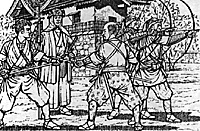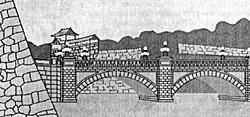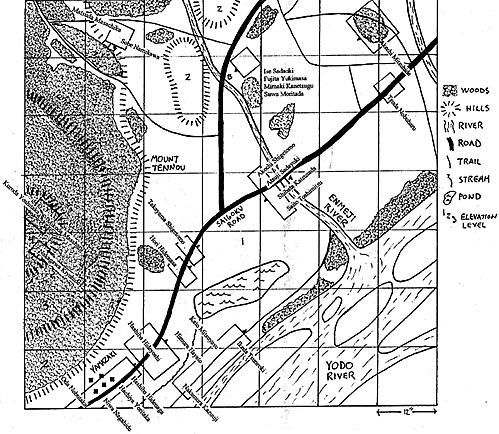 From a humble origin was the future ruler and unifier of Japan born. Running away from the priesthood, he purchased his own armor and sword and joined Nobunaga's Army. From virtual obscurity this simple ashigaru, by merit alone, rose through the ranks of Nobunaga's Army to become one of his most trusted Generals. His name was Hashiba Hideyoshi, or, as he would later become known, Toyotomi Hideyoshi.
From a humble origin was the future ruler and unifier of Japan born. Running away from the priesthood, he purchased his own armor and sword and joined Nobunaga's Army. From virtual obscurity this simple ashigaru, by merit alone, rose through the ranks of Nobunaga's Army to become one of his most trusted Generals. His name was Hashiba Hideyoshi, or, as he would later become known, Toyotomi Hideyoshi.
The following scenario is an extract from the future "Hideyoshi's Battles" book; which is for use with the ruleset "Killer Katanas." The Battle of Yamazaki was a important event in Japanese history. With this victory, Hideyoshi set in motion his rise to dominance, which would eventually lead to his unification of Japan in 1590.
For those that have never heard of Killer Katanas, it is a set of miniature rules for recreating the battles of the Sengoku-jidai period from 1550-1615. They are oriented for mass battles, not skirmish like so many other sets of Samurai rules. There are two scales in the rules; one is 1:15/40--one man represents fifteen and a inch is forty feet (intended for small battles) and the other is 1:30/80 (intended for large battles). Figures are based four to a 1 1/2 "x 1/2 " stand for infantry, while cavalry are based two on a 1"x 1" stand. Bases are grouped into units (4 bases is a good minimum). All troops in the unit must have the same type of weapon. Each unit requires a leader figure; he is based individually on a 1/2 "x 1/2 " stand for infantry and 1/2 "x 1" for cavalry.
KK is played with a deck of 16 cards. In the deck are 4 cavalry and 4 infantry cards for each side. Each card has the movement allowance for the troop types. Cards are drawn one at a time, and only when a card is drawn may a unit move. A units movement allowance may have some modifications for actions such as turning, wheeling, firing, reloading and so on. After all cards are drawn the deck is reshuffled and a new turn begins.
 A unit may fire instead of moving on its card. Bows do not have to be loaded to do so, but arquebuses do. Casualties are computed by cross indexing the number of figures firing with the total fire factor. The result is a number expressed like 3.2, 4.4, 5.3 and so on. The first number preceding the digit is the number of kills inflicted. The second number is the die roll needed or less to inflict another casualty. Once a gunpowder weapon fires it is marked with cotton to show that it is not reloaded. To reload takes two cards of sitting and doing nothing.
A unit may fire instead of moving on its card. Bows do not have to be loaded to do so, but arquebuses do. Casualties are computed by cross indexing the number of figures firing with the total fire factor. The result is a number expressed like 3.2, 4.4, 5.3 and so on. The first number preceding the digit is the number of kills inflicted. The second number is the die roll needed or less to inflict another casualty. Once a gunpowder weapon fires it is marked with cotton to show that it is not reloaded. To reload takes two cards of sitting and doing nothing.
Units which make contact with one another conduct melee. This is handled like fire combat. Better weapons, such as lances, allow for a greater number of men to fight in the melee. The loser of the melee is pushed back and the victor may follow up. A melee can continue on subsequent cards.
Leaders help their units by adding bonuses to melee and morale. In addition, any coming within 10" of another may challenge them to personal combat.
The book underwent a great deal of research and used many Japanese sources in its design. For the first time in English all 22 battle formations are identified with diagrams. There are hundreds of identified Daimyos along with their statistics for use in games. There is also a page showing 38 Daimyo flags in color. there is also five scenarios: 4th Kawanakajima, Anegawa, Mikata-ga-hara, Nagashino and Sekigahara; each has a complete OOB. Future scenario books are in the works. The first scenario supplement "Tokugawa's Battles: Tennoji and Nagakute," and the second supplement "Date's Battles: Suriagehara and Domyoji," are now available. Either Shimazu's or Hideyoshi's Battles will be next.
On a final note, the rules are written for use with 15mm figures, but 25mm may be used by doubling all distances in the rules. I have made new cards and charts for both large and small battle scales and for 25mm use. These may be obtained from me via Internet or by writing to me.
The rules are available from Brookhurst Hobbies for $19.95. Killer Katanas has a web site for those interested: http://members.aol.com/KllrKatnas/index.html. Any questions may be sent to me at KllrKatnas@aol.com.
YAMAZAKI 13 JUNE 1582
 By April 1582 Oda's general Hideyoshi had advanced into the Mori's province of Bitchu and laid siege to their fortress of Takamatsu. After several failed assaults, Hideyoshi turned to engineering for a solution. Nearby flowed the Ashimori River, Hideyoshi had it diverted into the plain where the fortress lay. As the waters rose to the castle's walls, Hideyoshi erected towers and began bombarding the garrison. The commander of the fortress sent for help from Mori Terumoto. The help soon arrived in such strength that Hideyoshi sent word to Nobunaga asking for reinforcements. Nobunaga sent every soldier he could spare leaving himself with just 100 bodyguards in place of his normal 2,000.
By April 1582 Oda's general Hideyoshi had advanced into the Mori's province of Bitchu and laid siege to their fortress of Takamatsu. After several failed assaults, Hideyoshi turned to engineering for a solution. Nearby flowed the Ashimori River, Hideyoshi had it diverted into the plain where the fortress lay. As the waters rose to the castle's walls, Hideyoshi erected towers and began bombarding the garrison. The commander of the fortress sent for help from Mori Terumoto. The help soon arrived in such strength that Hideyoshi sent word to Nobunaga asking for reinforcements. Nobunaga sent every soldier he could spare leaving himself with just 100 bodyguards in place of his normal 2,000.
One of Nobunaga's other generals, Akechi Mitsuhide, had earlier failed in his campaign against the Mori and was humiliated by Nobunaga. Earlier in his career he had captured the mother of Hatano Hideharu and used her to force his capitation. When the general was brought before Nobunaga he ordered him killed. Hatano's retainers responded by taking Mitsuhide's mother as hostage and later killing her. Akechi held on to his hatred of Nobunaga for five years, and now it was his time for revenge. Turning his troops around he marched back to Kyoto, surrounded Nobunaga's mansion at Honno-ji, and attacked; no quarter was given. Nobunaga committed seppuku as his mansion burned around him.
Akechi retired to his castle at Sakamoto. On June 6, he attacked and seized the Hideyoshi's stronghold of Nagahama and later Wakayama, owned by Niwa Nagahide. After a brief return to his capital, Mitsuhide went to Kyoto and sent word to the Shogun requesting reinforcements for the upcoming fight against Hideyoshi. On the 10th , he learned that Hideyoshi was fast approaching with an army. He left Kyoto to join his ally Tsutsui Junkei near Hokoraga pass and assembled his army.
On June 3, Hideyoshi got news of Nobunaga's death. He immediately made peace with the Mori and marched back to Himeji Castle to prepare. On the 9th he traveled to Settsu Amagasaki (name of a place) to ask for Oda Nobutaka and Niwa Nagahide's help; they readily agreed. By June 12 the army was within striking range of Akechi's army.
That night Hideyoshi's general Takayama Shigetomo occupied the nearby village of Yamazaki while Nakagawa Kiyohide took the heights on Mount Tennou. The rest of Hideyoshi's army moved forward to positions around Yamazaki. In the morning, Akechi moved his troops from Shouryuji Castle and assembled them near the Enmeiji River. He positioned Tsuda Nobuharu with 2,000 troops on the left wing. Across the river and located in the center was Shibata Katsusada's and Saito Toshimitsu's 2,000 and Atsuji Sadayuki's and Akechi Shigetomo's 3,000. On the right wing was Ise Sadaoki's, Suwa Moritada's, Fujita Yukimasa's and Mimaki Kanetsugu's 2,000 troops. On the extreme right, positioned to assault Mount Tennou, was Matsuda Masachika and Sobe Namikawa with 2,000. Behind the main lines and located on Obouzuka was Akechi Mitsuhide's main body of 5,000.
At 3 P.M. Hideyoshi moved his forces towards Akechi. On the right wing traveling up a trail was Ikeda Tsuneoki's and Kato Mitsuyasu's 5,000. Following them was Himura Hayato and Nakamura Kazuuji with approximately 2,000 troops each. In the center traveling up the Saigoku road was Takayama Shigetomo's 2,000 troops, followed closely by Hori Hidemasa with approximately 2,000. On the left wing on top of Mount Tennou was Mikoda Masaharu and Kuroda Yoshitaka with about 2,000 each, and Nakayama Kiyohide with 2,500 men. In the rear on the Saigoku Road was the main body of Hideyoshi about 6,000 strong. Behind Hideyoshi was his brother, Hashiba Hidenaga, with about 2,000 men and Hachiya Yoritaka, with approximately 2,000 men. Niwa Nagahide's 3,000 and Oda Nobutaka's 4,000 followed as rearguards.
It was raining at 4 P.M. when Takayama and Hori began the battle. While Takayama took on Saito's forces, Hori engaged Shigetomo's, Atsuji's and Shibata's troops. The divisions under Ikeda, Himura, Kato and Nakamura immediately advanced in support of their allies. On the right flank Ikeda brought his troops forward and flanked Saito's troops, driving them back across the river. Shigetomo and the other three divisions near him were also pushed back across the river. Meanwhile, on Mount Tennou, Mikoda, Kuroda, and Nakagawa advanced and drove off Sobe's and Matsuda's forces as they climbed. They then turned and advanced on the Akechi's right flank. Soon Hideyoshi's forces had advanced across the river. A flanking movement by Kato cut off Tsuda and his men were soon surrounded. During this time Hideyoshi advanced his main body forward, while Oda, Hichiya, Hidenaga and Niwa advanced their divisions to flank the Akechis on the right.
Around 5 P.M. the Akechi right flank was turned. Sandwiched between Hideyoshi's men and the river, the Akechis were in serious trouble. Mimaki proposed a retreat and acted as a decoy for his fellow generals. Mitsuhide ran back to Shouryuji Castle, but the castle was surrounded by Hideyoshi's men by nightfall. At night Mitsuhide sneaked out of the castle and proceeded to his capital, but he was located and killed by farmers as he made his way through the rice fields. Only 13 days before he had had turned on Nobunaga; a swift revenge for Hideyoshi. Upon hearing the news, Mitsuhide's family committed suicide.
The losses in the battle were fairly equal; 3,300 for Hideyoshi and 3,000 for Akechi. Hideyoshi had won a victory which placed him at the top of his rivals. There would be eight more years of conflict, then Japan would be finally unified under his iron hand.
| HIDEYOSHI | AKECHI |
|---|---|
| ON BOARD: | ON BOARD: |
| * Hashiba Hideyoshi - 6,000 (+3) | * Akechi Mitsuhide - 5,000 (+3) |
| Takayama Shigetomo - 2,000 (+1) | Tsuda Nobuharu - 2,000 (+1) |
| Nakagawa Kiyohide - 2,500 (+0) | Saito Toshimitsu - 1,000 (+1) |
| Hori Hidemasa - 2,000 (+2) | Shibata Katsusada - 1,000 (+0) |
| Ikeda Tsuneoki - 2,500 (+2) | Atsuji Sadayuki -1,500 (+0) |
| Kato Mitsuyasu - 2,500 (+1) | Akechi Shigetomo - 1,500 (+1) |
| Himura Hayato - 2,000 (+0) | Sobe Namikawa - 1,000 (+0) |
| Nakamura Kazuuji - 2,000 (+0) | Matsuda Masachika - 1,000 (-1) |
| Mikoda Masaharu - 2,000 (+1) | Ise Sadaoki - 500 (+1) |
| Kuroda Yoshitaka - 2,000 (+1) | Suwa Moritada - 500 (+0) |
| Hashiba Hidenaga - 2,000 (+1) | Mimaki Kanetsugu - 500 (+2) |
| Hachiya Yoritaka - 2,000 (+0) | Fujita Yukimasa - 500 (+0) |
| Niwa Nagahide - 3,000 (+1) Oda Nobutaka - 4,000 (+0) | - |
| TROOPS AVAILABLE: | TROOPS AVAILABLE: |
| 3120 MTD SAM w/CLNC | 1370 MTD SAM w/CLNC |
| 165 MTD SAM w/BOW | 70 MTD SAM w/BOW |
| 3535 FT SAM w/LNC | 1550 FT SAM w/LNC |
| 2360 FT SAM w/LS | 1035 FT SAM w/LS |
| 1040 FT SAM w/BOW | 455 FT SAM w/BOW |
| 8320 ASH w/ARQ | 3650 ASH w/ARQ |
| 3120 ASH w/BOW | 1370 ASH w/BOW |
| 5620 ASH w/LNC | 2460 ASH w/LNC |
| 3745 ASH w/LS | 1640 ASH w/LS |
| 5475 ASH w/OTHER | 2400 ASH w/OTHER |
| 18 x UNATTACHED LDR | 8 x UNATTACHED LDR |
GAME LENGTH:
The battle begins at 4 P.M. and ends at 6:30 P.M. (10 turns)
SPECIAL RULES:
* Akechi's forces are set up first, followed by Hideyoshi's.
* Akechi's division under Ise, Fujita, Mimaki and Suwa may form anywhere in their area.
* Optional rule 16.1 is in play. Command range for Hideyoshi and Akechi is 30". All others have a 15" range.
* Optional rule 16.8 is in play for both sides.
* Optional rule 16.9 is recommended for the game.
* There is a light rain coming down over the battlefield. While it is raining optional rule 16.10 is in play. At the beginning of every turn the GM should roll a die, on a 6 it has stopped raining.
* The Enmeiji River and the other minor river near Mitsuhide may both be forded along their length.
* The Yodo River is off limits to all.
* All woods up to the 2nd level are light, all others are heavy.
* The lake is shallow and may be entered up to 2".
* Mount Tennou is steep.
* The two smaller hills are gentle.
VICTORY CONDITIONS:
The victory goes to the side who has the most victory points at the end of turn 10. Points are as follows:
TERRAIN
Control of Enmeiji bridges*
(A) 3 VP
(B) 2 VP
*Control goes to the last side to occupy or pass through each bridge.
| CASUALTIES | Damage on the enemy: |
|---|---|
| 5% 1 VP | 30% 6 VP |
| 10% 2 VP | 35% 7 VP |
| 15% 3 VP | 40% 8 VP |
| 20% 4 VP | 45% 9 VP |
| 25% 5 VP | 50% 10 VP |
OTHER:
Only found two other leaders for the Akechi. They may not be used as unattached leaders.
AKECHI
Kobi? * +0
Murakami Kiyokuni ** +1
* Fought with Ise's forces
** Fought in Tsuda's division.
NOTES:
This was a difficult battle to design. I used information from Gakken and Nihon Senshi, but both had different accounts of the battle, organization, and starting positions. I have primarily used Nihon Senshi because I believe the source to be more accurate.
Trees were not provided, but I know that Mount Tennou was covered in dense thicket. All other trees are based on paintings provided by Gakken.
My thanks goes to Hiroshi Takahashi and Norio Sakuta for their translations from Japanese sources (my Japanese is atrocious!).
BIBLIOGRAPHY:
Nobuyuki, Tamaru (Ed)., Strategy, Tactics, Weapons: Japanese Age of Battles edition , Graphic Rekishi series., Gakushu Kenkyusha, Tokyo, 1994. In Japanese.
Sanbu, Honbu., Nihon Senshi (Fukkoku edition) , vol. 10 Yamazaki no eki., Rikugun, Tokyo 1977. In Japanese.
Takeo, Oda (Ed)., Rekishi Gunzo : no. 3 (July 87), no. 30 (Sep 92), no. 45 (Jan 96)., Gakushu Kenkyu Sha, Tokyo. In Japanese.

Back to The Gauntlet No. 12 Table of Contents
Back to The Gauntlet List of Issues
Back to Master Magazine List
© Copyright 1998 by Craig Martelle Publications
This article appears in MagWeb (Magazine Web) on the Internet World Wide Web.
Other military history articles and gaming articles are available at http://www.magweb.com